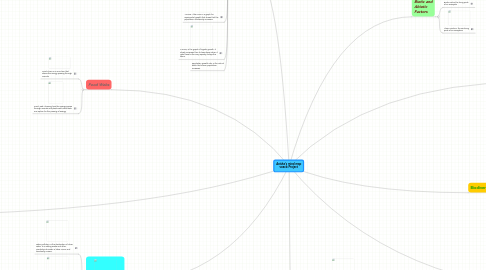Anisha's mind map voacb Project
by anisha wilson

1. Ecosystems
1.1. Rainforests are wet hot areas in which there are many different types of animals and plants
1.2. Temperate decidous Forest is an ecosystem tha is both hot, cold, wet, and dry. Pennsylvania is in the temperate decidous forest ecosystem.
1.3. Desert is dry, and very hot ecosystem that have many animals including many reptiles.
1.4. The Tundra ecosystem is a cold and dry ecosystem.
1.5. Coniferous Forest is also a hot, cold, wet. and dry ecosystem.
1.6. Grassland/Savannah are hot, sometimtes cold, and dry ecosystem.
1.7. Fresh water biome is an ecosystem with warm non-salt water.
1.8. Marine Biome: a wamr water biome with warm water.
2. Levels of Organization Pyramids
2.1. Organism: any form of life
2.2. Population: a group of indivisuals of the same species found in a given area or located in the same area at a given time
2.3. Community: it consists of the population of living organisma that interact with one another in an ecosystem.
2.4. Ecosystem: a group of living organisma that interact one another and nonliving physical envionment.
2.5. Biome: is a geographic region of Earth that is inhabited by a community of distinct types of plant and animals species
2.6. Biosphere: a layer of soil, water, and air that sustains life
3. Food Webs
3.1. Food Chain-is a one chain that shows the energy passing through animals
3.2. Food Web- showing how the energy passes through animals and plants wiht more thatn one option for the passing of energy
4. Biotic and Abiotic Factors
4.1. Biotic Factor-the living parts of an ecosystm
4.2. Abioic Factors- the nonliving parts of an ecosystem
5. Trophic Level Pyramid
5.1. Producers: are the organisms that produce their won energy from the sun
5.2. Primary Consumers: !st degree consumer that eats producers. gets 10% of energy
5.3. Secndary Consumers: 2nd dgree cunsumer. eats Primary Cunsumers and sometimes producers. they get 1% of energy.
5.4. Tertiary Conusumers: 3rd degree consumer. eats seconardy consumers. get. .1%. of energy.
5.5. Trophis Levels; each step in the transfer of enrgy through an ecosystem
6. Limiting Factors
6.1. Limiting factors: are condtions of the enviovment that limit the growth of a species.
6.2. carrying Capacity: is the number of individuals of a species that on ecosystem can support.
6.3. Ecplogical Succession: the process of an ecosystem growing back and evolving out of nothing.
6.4. Primary Sucession; occurs where there has never been an ecosystem.
6.5. secondary Succession; occurs in a place that an ecosystem was destoryed.
6.6. Pioneer Speies: the first species to move into an ecosystem.
6.7. Climax Community: the end insuccession where there is little of no change in species
7. Biodiversity
7.1. Biodiversity: is the variety of organisms in a geographic area.
7.2. Hot SPots: are regions on the earth where there is more than half of the world's species in an eosystem
8. Population
8.1. population growth: the gorwth of huam population on the earth.
8.2. Black Plague: was a disease during the 1400s that wipped out 1/3 of the world population.
8.3. Industrail Revolution: was in the 1700s-1800s that drastically increased the human poplution. Ever since the Industrail Revolution, the human popultion has constantly inceased alot. The advances during the Industrial Revolution where in energy, medicine and tranportation.
8.4. exponential grotwth: is the increase in human population that mutiplies every time.
8.5. sustainability: is the ablitly to sustain an ecosystem, and human population.
8.6. logistic growth: is a growth of population in which a population grow continuesly untill i comes to the carry capacity. Then it the number of population stays the same.
8.7. J-Curve: I the curve in a graph for exponentail growth that shows that the population constainaly increases.
8.8. S-curve; is the graph of logistic growth. It slowly increases then it slows down when it gets close to the carry apacity it stays the same.
8.9. population growth rate: is the rate at which the human population increases.
9. Water Pollution
9.1. water pollution: is the destruction of clean water. it is adding waste and other products into water in lakes, rivers, and eventually oceans.
9.2. Point-source pollution: is water pollution in whihc there is only one source that is pollutes the water. Examples: factories or wastewater treatment plants.
9.3. Non-point pollution: a large amount of water polluition that comes from many different sources. Examples: fertilizing a lawn, driving cars, and storm drains.
9.4. Aquifer: is an underground river, lake, or resorver.


